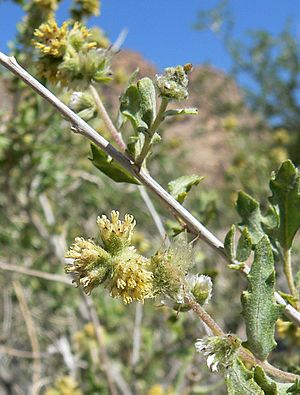Woolly bursage facts for kids
Quick facts for kids Woolly bursage |
|
|---|---|
 |
|
| Woolly bursage on a dry river bed in Red Rock Canyon, Nevada. | |
| Scientific classification | |
| Genus: |
Ambrosia
|
| Species: |
eriocentra
|
| Synonyms | |
|
|
The Woolly Bursage (scientific name: Ambrosia eriocentra) is a type of plant found in North America. People also call it Woollyfruit Burr Ragweed. It belongs to the ragweed family.
Contents
Where Does Woolly Bursage Grow?
This plant is native to the Mojave Desert. This desert is located in the southwestern United States. You can find it in parts of southern California, southern Nevada, northwestern Arizona, and southwestern Utah.
It likes to grow in the flat areas and on the mountain ridges of the Mojave Desert. It can be found at elevations up to about 1,700 meters (5,577 feet) high.
What Does Woolly Bursage Look Like?
The Woolly Bursage is a rounded shrub that can grow taller than 1.5 meters (5 feet).
Stems and Leaves
Its stems are a brownish-gray color. The younger branches are covered in soft, woolly fibers, which is how it gets its "woolly" name. Older branches are smooth. The leaves are shaped like a spearhead and can be up to 9 centimeters (3.5 inches) long. They have rolled edges that are either lobed or toothed.
Flowers and Fruit
Like other ragweeds, the Woolly Bursage has special flower clusters. It has a few male flower heads that produce pollen. Next to these are several female flower heads, each with a single flower. The plant usually blooms from April to June.
The fruit of the Woolly Bursage is a green, spiky burr. It has long, soft, white hairs and several sharp spines with hair tufts. Each burr is about 1 centimeter (0.4 inches) long.

